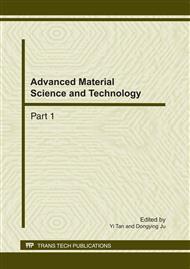p.1245
p.1249
p.1253
p.1259
p.1263
p.1267
p.1271
p.1275
p.1279
Antiferromagnetic Layer Thickness Dependence of Exchange Bias in Sputter-Deposited Co/CoO/Co Trilayer
Abstract:
We have used ferromagnet/antiferromagnet/ferromagnet sandwich structure to probe the antiferromagnetic layer thickness dependence of exchange bias in sputter-deposited Co/CoO/Co trilayer. The exchange coupling occurring at the upper ferromagnetic/antiferromagnetic interface is always found to be stronger than the one at the lower antiferromagnetic/ferromagnetic interface. The grain growth with increasing antiferromagnetic layer thickness can lead to a gradient of grain size distribution through the whole antiferromagnetic layer. Consequently, the relatively large grains at the upper interface would results in a rougher interface which we treat as structural defects and can significantly enhance exchange bias through domain state model. The slightly decrease of exchange coupling with increasing antiferromgnetic layer thickness indicates that the exchange bias is only governed by the grains that are thermally stable but whose anisotropy energy is low enough to be set.
Info:
Periodical:
Pages:
1263-1266
Citation:
Online since:
February 2011
Authors:
Price:
Сopyright:
© 2011 Trans Tech Publications Ltd. All Rights Reserved
Share:
Citation:


